InterviewSolution
Saved Bookmarks
This section includes InterviewSolutions, each offering curated multiple-choice questions to sharpen your knowledge and support exam preparation. Choose a topic below to get started.
| 14901. |
Question : Mention two differences between tadpole and adult frog. |
Answer» SOLUTION :
|
|
| 14902. |
Question : Mention two common characters shared by all gymnosperms. |
| Answer» Solution :PRESENCE of NAKED ovules, BORNE unprotected on the surface of the megasporophylls, ABSENCE of vessels inxylem. | |
| 14903. |
Question : Mention two characters shared by gymnosperms and angiosperms ? |
|
Answer» Solution :1. Both PLANT groups PRODUCE seeds. 2. PRESENCE of Eustele 3.Presence of well organised plant body with roots, stem and leaves. |
|
| 14904. |
Question : Mention three salient features of Phylum Ctenophora. |
|
Answer» SOLUTION :Bioluminescence (the ability of a living organism to EMIT light) is well marked in Ctenophores. 2. They lack nematocyte but possess special cells called lasso cells or colloblasts to CAPTURE food. 3. They show indirect development and the larva is called CYDIPPID. EG: Pleurobrachia. |
|
| 14905. |
Question : Mention three salient features of Solanaceae. |
|
Answer» Solution :CALYX OFTEN persistent / ACCRESCENT. Stamens 5, epipetalous, poricidal dehiscence. |
|
| 14906. |
Question : Mention three salient features of Fabaceae. |
|
Answer» Solution :1. Corolla: Papilionaceous, descendingly IMBRICATE aestivation, POSTERIOR petal outermost. 2. Stamens: Monadclphous. Diadclphous. 3. Ovary stipitate (a short STALK as the base), monocarpellary. UNILOCULAR with marginal placentation. |
|
| 14907. |
Question : Mention three salient features of Brown algae. |
|
Answer» Solution :1. The thallus is differentiated into leaf like PHOTOSYNTHETIC part called frond , a STALK like structure called STIPE and a holdfast. 2. A part from CHLOROPHYLLS, Carotenoids and fucoxanthin is present. 3. Mannitol and Laminarin are the reservefood MATERIALS. |
|
| 14908. |
Question : Mention three cell organelles viisble under a light microscope. |
| Answer» SOLUTION :MITOCHONDRIA, GOLGI APPARATUS, CENTROSOME. | |
| 14909. |
Question : Mention the various ways by which genetic recombination occurs. |
| Answer» SOLUTION :GENETIC recombination in bacteria occurs by conjugation , TRANSDUCTION and transformation. | |
| 14910. |
Question : Mention the types of special inflorescence. |
|
Answer» Solution :1. CYATHIUM 2. HYPANTHODIUM 3. COENANTHIUM |
|
| 14911. |
Question : List the types of senescence. |
|
Answer» Solution :Leopold (1961) has RECOGNISED FOUR TYPES of senescence: i. Overall senescence ii. Top senescenceiii. Deciduous senescence IV. Progressive senescence |
|
| 14912. |
Question : Mention the types of muscles present in athletes taking part in marathon and sprint. Differentiate between them. |
Answer» SOLUTION :MARATHON - RED muscle, sprint -WHITE muscle 
|
|
| 14913. |
Question : Mention the types of leaves based on petiole. |
| Answer» Solution :A leaf with PETIOLE is SAID to be petiolate. e.g. HIBISCUS. Leaves that do not possess petiole is said to be SESSILE. eg. Calotropis. | |
| 14914. |
Question : Mention the types of mixed inflorescence. |
| Answer» SOLUTION :THYRSUS and VERTICILLASTER. | |
| 14915. |
Question : Give examples of electron transport chain inhibitors . |
|
Answer» Solution :Eelectron transport chain INHIBITORS : 1. 2, 4 DNP (Dinitrophenol) - It prevents synthesis of ATP from ADP , as it DIRECTS electrons from Co Q to `O_2` 2. Cyanide - It prevents flow of electrons from CYTOCHROME `a_3 "to" O_2`. 3. Rotanone - It prevents flow of electrons from `NADH + H^+ // FADH_2 "to" Co Q` 4. Oligomycin - It inhibits OXIDATIVE phosphorylation . |
|
| 14916. |
Question : Mention the types of Cymose inflorescence. (or) Explain in detail about the types of cymose inflorescence. |
|
Answer» Solution :Cymose: Central axis STOPS growing and ends in a FLOWER, Further GROWTH is by means of axillary buds. OLD flowers present at apex and young flowers at base. Types of cymose: Simple cyme (Solitary): Determine inflorescenceconsists ofa single flower. It may be terminal or axillary. Eg: Hibiscus. 2. Monochasial Cyme (Uniparous): The main axis ends with a flower. From two lateral bracts, Only one branch grows further. It may be Helicoid or Scorpioid. (a) Helicoid: Axis develop on only one side and looks like a coil, atleast during the stage of early development. Eg: Hamelia, Potato. 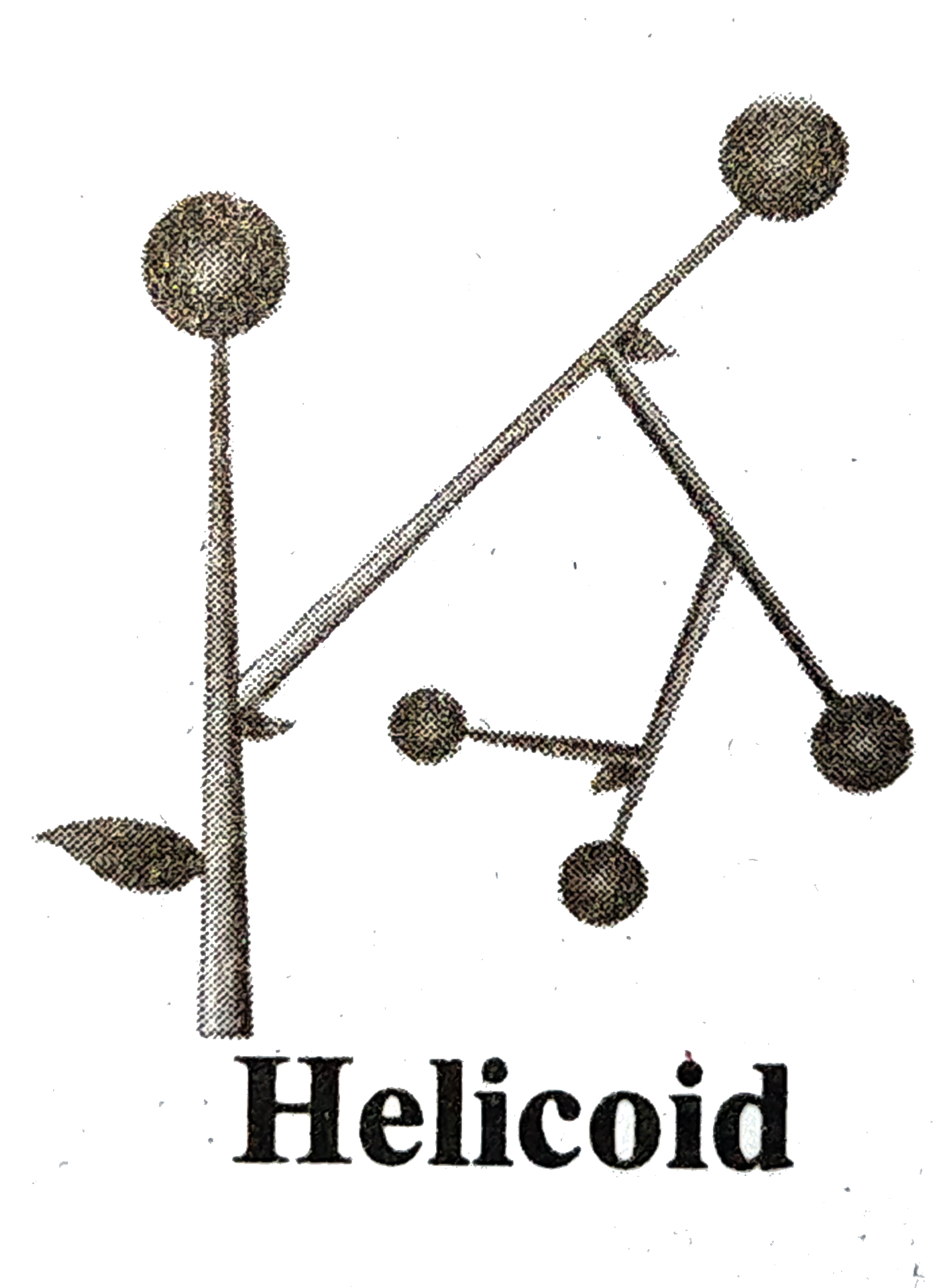 (b) Scorpioid: Monochasial cyme in which axes develop on alternate sides. Eg: Heliotropium. 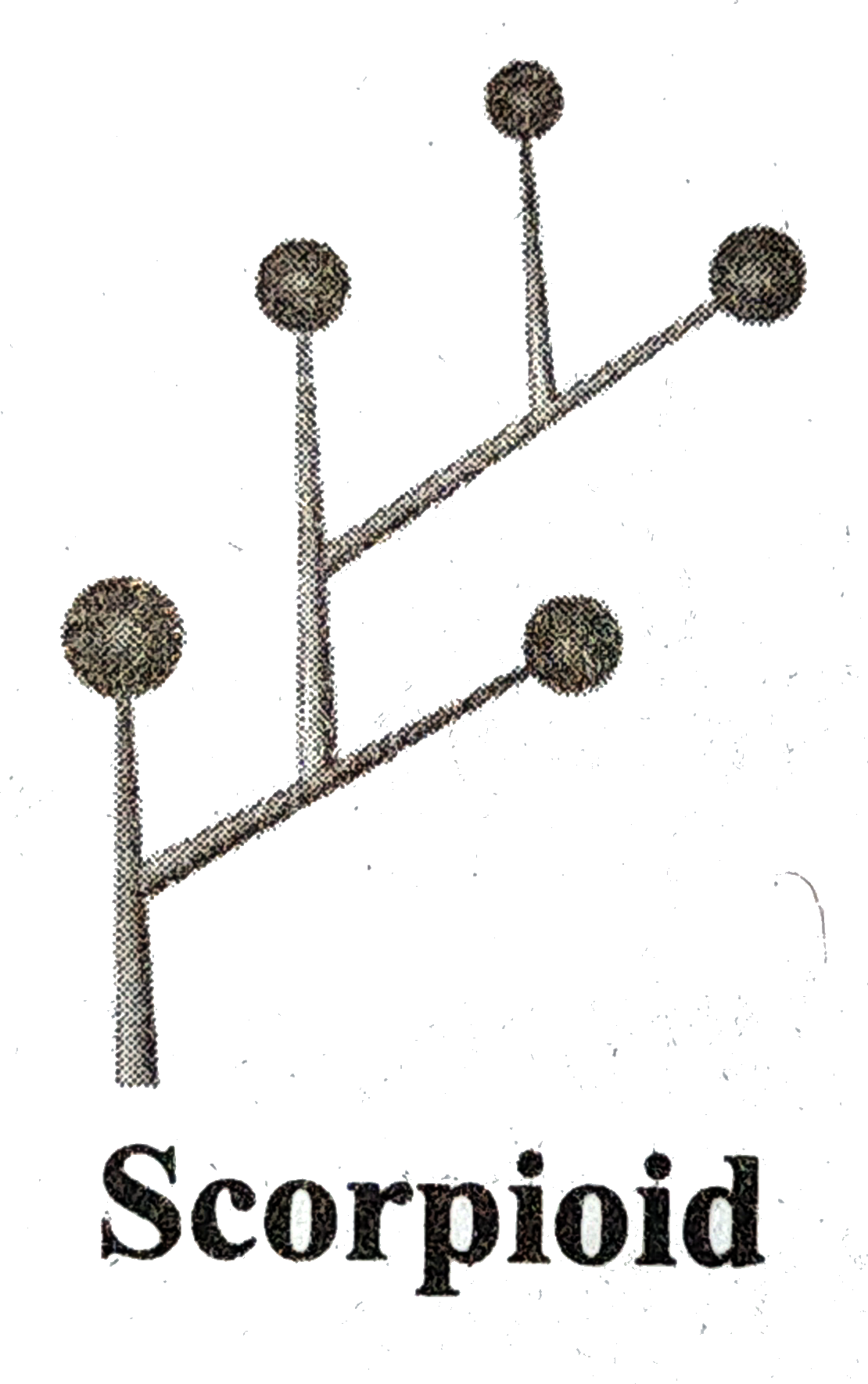 3. Simple dichasium (Biparous): (i) A central axis ends in a terminal flower, further growth is produced by two lateral buds. (ii) Each cyme consists of three flowers of which central one is old one. This is true cyme. Eg: Jasminum. 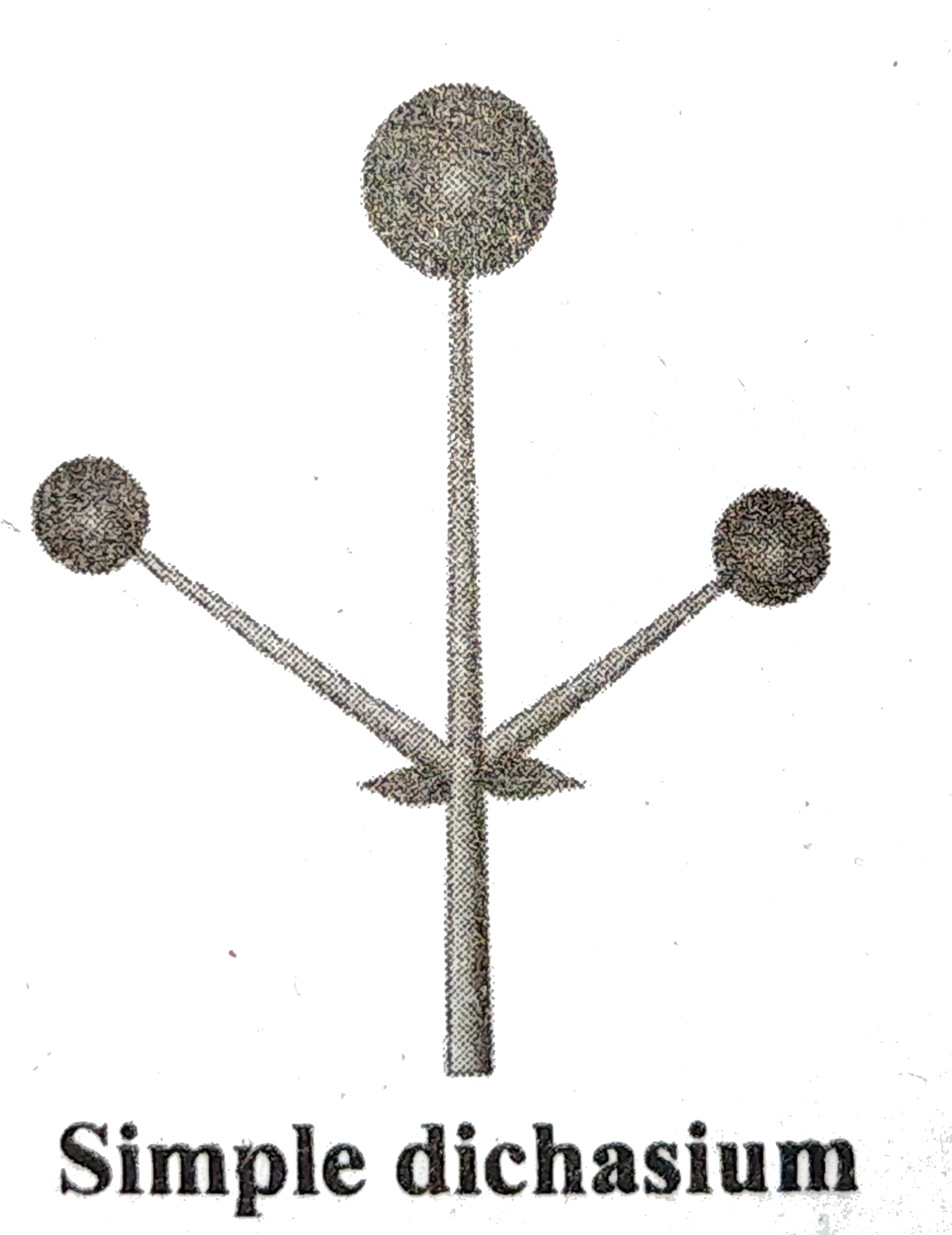 4. Compound dichasium: It has many flowers. A terminal old flower has lateral simple DICHASIAL cyme on both sides. Each compound dichasium consists of seven flowers. Eg: Clerodendron 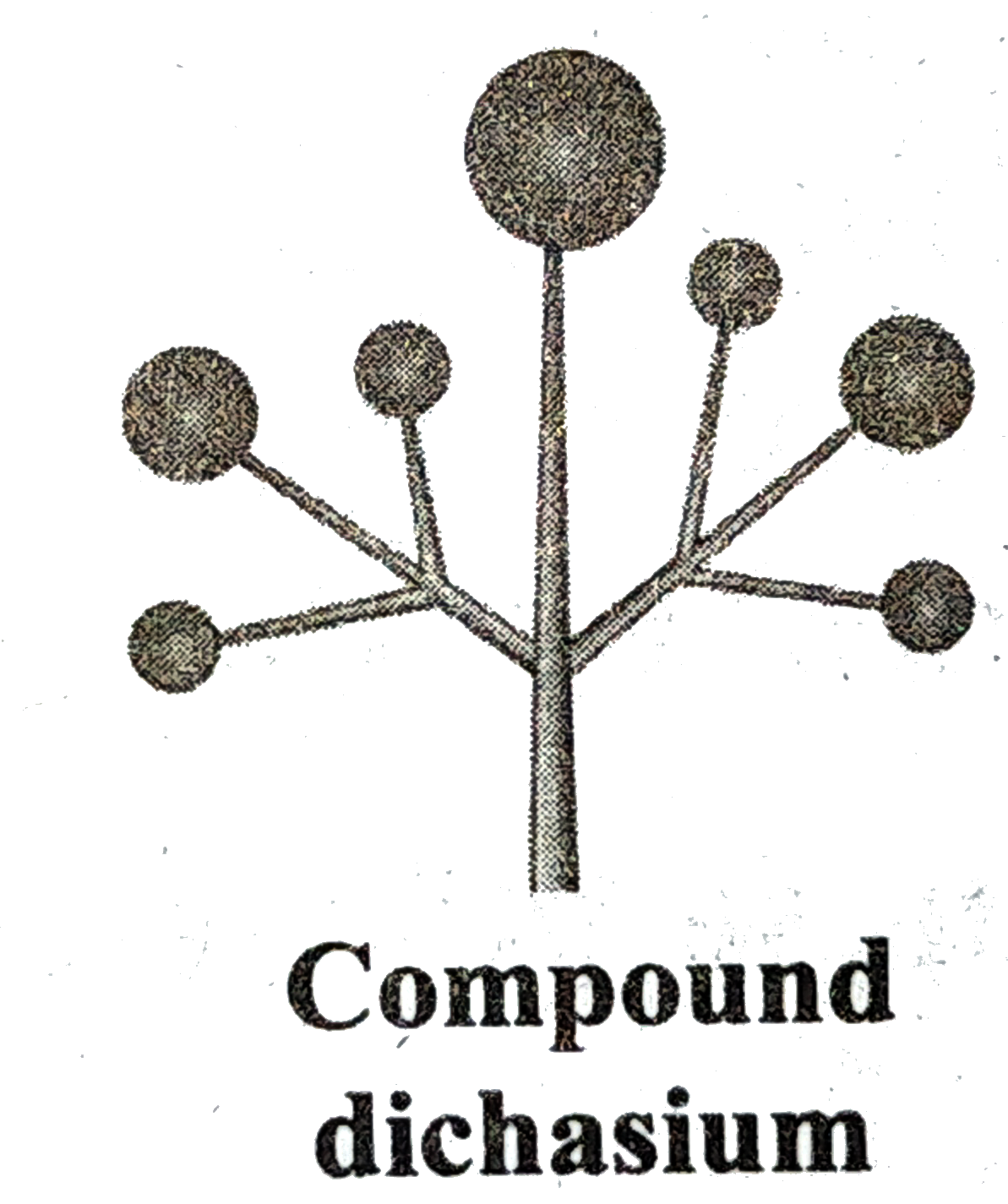 5. Polychasial Cyme (Multiparous): The central axis ends with a flower. The lateral axes branches repeatedly. Eg: Nerium. 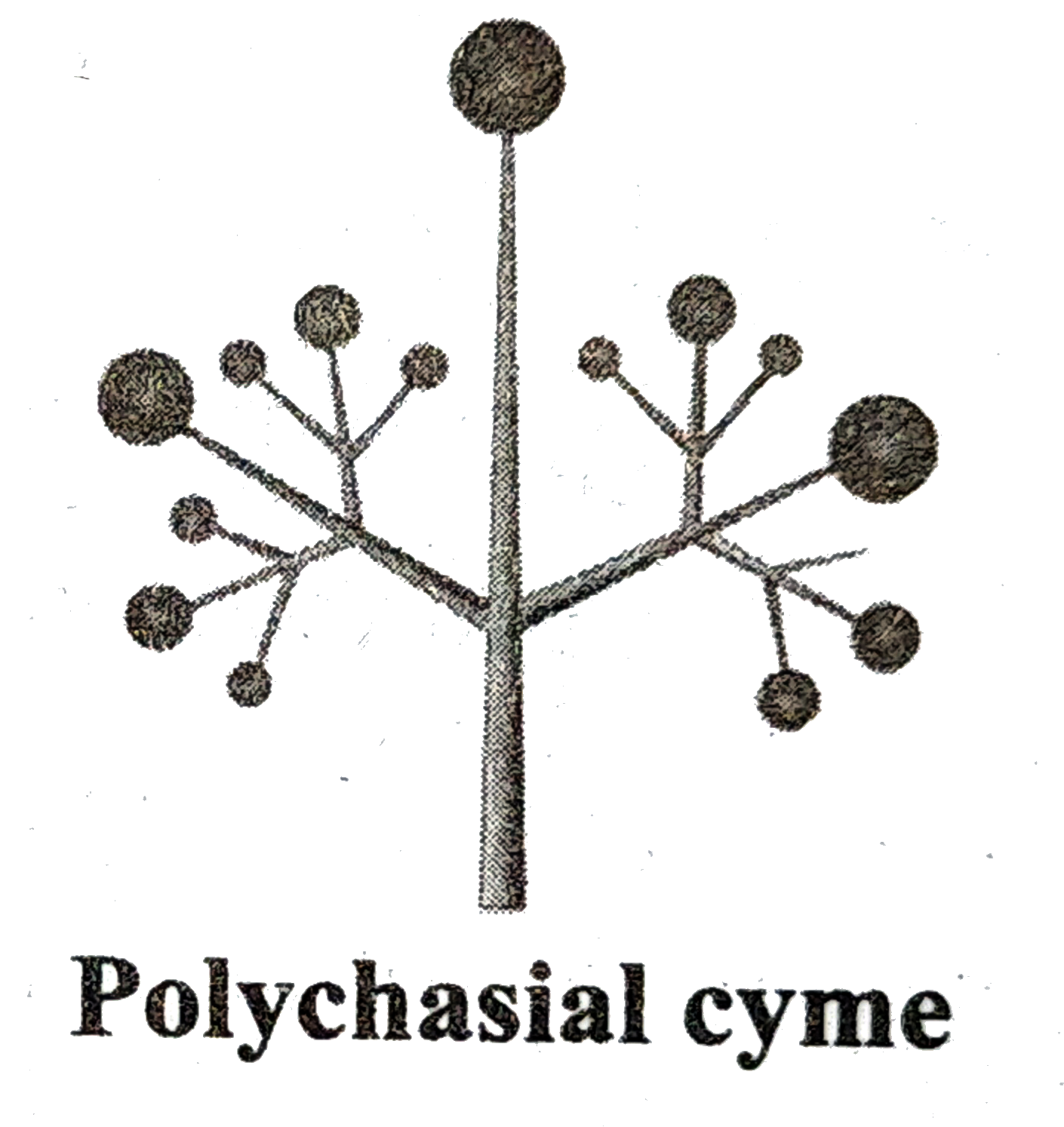
|
|
| 14918. |
Question : Mention the two phase of Glycolysis. |
| Answer» Solution :(a) Preparatory phase or HEXOSE phase, (B) PAY off phase or TRIOSE phase. | |
| 14919. |
Question : Mention the three types of joints found in human body. Which of these play a significant role in locomotion. |
|
Answer» SOLUTION :FIBROUS joints - do not ALLOW movement CARTILAGINOUS joints - slight movement synovial joints - freely movable (help in locomotion) |
|
| 14920. |
Question : Mention the three possible ways by which ammonia is converted into aminoacids during nitrogen metabolism. |
|
Answer» Solution :Ammonia is CONVERTED into AMINO ACIDS by FOLLOWING PROCESSES : (a) Reductive amination , (b) Trans-amination and (c ) Catalytic amination. |
|
| 14921. |
Question : Mention the symbolicrepresentation of water potential andosmotic pressure. |
|
Answer» Solution :WATER potential - `Psi`(psi) and OSMOTIC PRESSURE - `pi` (pi). |
|
| 14922. |
Question : Mention the steps involved in the sexual reproduction of Rhizopus. |
|
Answer» Solution :Sexual reproduction: 1. Sexual reproduction is present and takes place through gametangial copulation. 2. Most of the species are heterothallic but Rhizopus sexualis is homothallic. 3. There is no MORPHOLOGICAL distinction between the two sexual hyphae although physiologically they are dissimilar. 4. Since physiologically dissimilar thalli (hyphae) are involved in sexual reproduction, this phenomenon is CALLED heterothallism. 5. Mycelia which produce gametangia are of opposite strains (+) or (-).  Formation of progamctangium: 1. The first step is the formation of special hyphae called zygophorcs. 2. The tips of the two zygophores swell to form progametangia. 3. Further, a septum is formed near the TIP of each progametangium and RESULTS in the formation of a terminal gametangium and a suspensor cell. Formation of zygosphore: 1. The two gametangia fuse, and this is followed by plasmogamy and karyogamy. 2. The fusion of nuclei results in the formation of a diploid zygospore. 3. Many nuclei belonging to opposite strains (+or -) PAIR and fuse to form many diploid nuclei. Formation of zygosporangium: 1. The zygospore enlarges and develops an outer thick dark and warty layer called exine and inner thin layer called intine. 2. After the resting period the nuclei of zygospore undergo meiosis. 3. The zygospore germinates to form sporangiophores and the zygosporangium contain mixture of (+) and (-) spores. 4. When the spores fall on a suitable substratum, they germinate to produce mycelium. 
|
|
| 14923. |
Question : Name the stages of aerobic respiration. |
|
Answer» Solution :1. Glycolysis-conversion of glucose into pyruvic ACID in cytoplasm of cell. 2. Link reaction-conversion of pyruvic acid inot acetyl COENZYME - A in mitochondrial matrix. 3. Krebs cycle-conversion of acetyl coenzyme A into CARBON DIOXIDE and water in the mitochondrial matrix. |
|
| 14924. |
Question : Mention the site,where sclerite is present in cockroach. |
| Answer» SOLUTION :In the EXOSKELETON all over the BODY | |
| 14925. |
Question : Mention the special features of eye in cockroach. |
|
Answer» Solution :(i) Situated at dorsal SURFACE of HEAD. (ii) Each EYE consists of about 2000 hexagon ommatidia. (iii) It can receive several images of an object. (iv) This kind of vision is KNOWN as mosaic vision. (v) It is more sensitivity but LESS resolution. |
|
| 14926. |
Question : Mention the size of bacteriophage and tobacco mosaic virus (TMV) . |
| Answer» Solution :Bacteriophage measures about 10-100 nm in SIZE. The size of TMV is is `300 xx 20 nm`. | |
| 14927. |
Question : Mentionthe significance of photosynthesis. |
|
Answer» Solution :Significance of Photosynthesis : 1. Photosyntheticorganisms providefood for all livingorganisms on earth eitherdirectlyor indirectly . 2. It isthe onlynatural PROCESS that liberates oxygen in THEATMOSPHERE and balances the oxygen level. 3. Photosynthesis balances the oxygen and carbon cyclein nature . 4. Fuelssuch as coal, petroleumand otherfossil fuelsare from presevedphotosyntheticplants . 5. Photosyntheitcorgansimsare theprimaryon whichall consumers depend forenergy . 6. Plants provide fodder , fiber, fire wood,timber, useful medicinal PRODUCTS and thesesourcecomeby the act of photosynthesis . |
|
| 14928. |
Question : Mention the significance of casparian strips. Where do you find them? |
| Answer» Solution :CASPARIAN STRIPS are found in endodermis and MAKE them water IMPERMEABLE. | |
| 14929. |
Question : Mention the secondary functions of leaf with an example for each. |
Answer» SOLUTION :
|
|
| 14930. |
Question : Mention the role of Sulphur in plants. |
|
Answer» SOLUTION :Sulphur (S) : Essential component of amino acids like cystine, cysteineand methionine, constituent of coenzyme A, Vitamins like biotin and thiamine, constituent of proteins and FERREDOXIN. Plants utilise sulphur as sulphate `(SO_4^-)` ions. Deficiency symptoms : CHLOROSIS, anthocyanin formation, stunted growth, rolling of leaf tip and reduced NODULATION in legumes. |
|
| 14931. |
Question : What is the role of light in photosynthesis? |
| Answer» Solution :Intensityof lightplaysa direct role in the RATEOF photosynthesis . Underlow intensity the photosyntheticrate islow and athigherintensityphotosyntheticrate is HIGHER . It alsodependson the nature of plants . Heliophytes (Beam Plants) REQUIRE higherintensitythanSciophytes(Oxalis). | |
| 14932. |
Question : Mention the role of Gibberellin in agriculture. |
|
Answer» Solution : • Formation of seedless fruits WITHOUT fertilization is induced by gibberellins. Example: Seedless tomato, APPLE and cucumber. • It promotes the formation of male flowers in cucurbitaceae. It helps in crop improvement. • Uniform bolting and increased uniform seed production. • Improves NUMBER and size of fruits in grapes. It increase yield. • Promotes elongation of inter-node in sugarcane without decreasing sugar content. • Promotion of flowering in long day plants EVEN under short day conditions. • It STIMULATES the seed germination. |
|
| 14933. |
Question : Mention the role of hormones in Abscission. |
| Answer» SOLUTION :All NATURALLY occurring hormones influence the process of ABSCISSION. AUXINS and cytokininsretard abscission, while abscisic acid (ABA) and ethylene induce it. | |
| 14934. |
Question : Mention the role of ethylene in agriculture field. |
|
Answer» Solution :• ETHYLENE normally reduces flowering in plants EXCEPT in Pine apple and Mango. • It increases the number of female flowers and decreases the number of MALE flowers. • Ethylene spray in cucumber crop PRODUCES female flowers and increases the YIELD. |
|
| 14935. |
Question : What is the agricltural role of ethylene? |
|
Answer» Solution :• Ethylene NORMALLY reduces flowering in plants except in Pine apple and Mango. •It increases the number of female flowers and decreases the number of male flowers. • Ethylene SPRAY in cucumber crop produces female flowers and increases the yield. |
|
| 14936. |
Question : Mention the role of Auxin in Agri-field. |
|
Answer» Solution :•It is used to ERADICATE weeds. EXAMPLE: 2,4-D and 2,4,5-T. • Synthetic auxins are used in the formation of seedless fruits (PARTHENOCARPIC fruit). • It is used to break the dormancy in SEEDS. • Induce flowering in Pineapple by NAA & 2,4-D. • Increase the number of FEMALE flowers and fruits in cucurbits. |
|
| 14937. |
Question : Mention the relation of frog with Human life |
| Answer» Solution :Frog is beneficial for mankind because they eat insects and protect the crop. Frogs maintain ECOLOGICAL balance because they SERVE as an important link of food chain and food web in the ECOSYSTEM. In some countries the muscular legs of the frog are USED as food by man. | |
| 14938. |
Question : Mention the relation of earthworm with human life. |
| Answer» Solution :Earthworms are ‘known as friends of farmers’ because they make burrows in the soil and make it porous which helps in RESPIRATION and penetration of the developing PLANT roots. The process of increasing fertility of soil by the earthworms is called vermicomposting. They are ALSO USED as bait in GAME fishing. 7.4 Cockroach : | |
| 14939. |
Question : Which combination of pressures makes a cell full turgid ? |
|
Answer» Solution :Turgor pressure andwallpressure MAKE the CELL FULLY turgid. `TP+ WP=` Turgid. |
|
| 14940. |
Question : Mention the precursors of (a) Auxin, (b) Gibberellin, (c) Cytokinin and (d) Abscisic acid. |
Answer» SOLUTION :
|
|
| 14941. |
Question : Name thepossible routes for the path of water across root cells. |
|
Answer» Solution :There are threepossible ROUTES of water. They are i) Apoplast,II) SYMPLAST and III) Transmemebrane ROUTE. |
|
| 14942. |
Question : Mention the ploidy of the following: protonemal cell of a - moss, primary endosperm nucleus in dicot, leaf cell of a moss, prothallus cell of a fern, gemma cell in Marchantia, meristem cell of monocot, ovum of a liverwort and zygote of a fern. |
| Answer» Solution :`{:("Protonemal cell of a MOSS",- ,"haploid (N)"),("Primary endosperm nucleus in dicot", - ,"triploid (3n)"),("LEAF cell of a moss",-,"haploid (n)"),("Prothallus cell of a fern",-,"haploid (n)"),("Gemma cell in Marchantia",-,"haploid (n)"),("MERISTEM cell of monocot",-,"diploid (2n)"),("Ovum of a liverwort",-,"haploid (n)"),("ZYGOTE of a fern",-,"diploid (2n)"):}` | |
| 14944. |
Question : Mention the ploidy of the following: protonemal cell of a moss, primary endosperm nucleus in dicot, leaf cell of a moss, prothallus cell of a fern, gemma cell in Marchantia, meristem cell of monocot, ovum of a liverwort and zygote of a fern. |
|
Answer» Solution :Protonemal cell of moss - haploid PRIMARY endosperm nucleus in DICOT- triploid leaf cell of a moss - haploid prothallus cell of a fern - haploid gemma cell in Marchentia - haploid meristem cell of monocot - diploid OVUM of a LIVERWORT - haploid zygote of a fern - diploid |
|
| 14945. |
Question : Mention the ploidy of the following: protonemal cell of a moss |
| Answer» SOLUTION :HAPLOID | |
| 14946. |
Question : Mention the ploidy of the following: ovum of a liverwort |
| Answer» SOLUTION :HAPLOID | |
| 14947. |
Question : Mention the ploidy of the following: primary endosperm nucleus in dicot |
| Answer» SOLUTION :TRIPLOID | |
| 14948. |
Question : Mention the ploidy of the following: prothallus cell of a fern |
| Answer» SOLUTION :HAPLOID | |
| 14949. |
Question : Mention the ploidy of the following: leaf cell of a moss |
| Answer» SOLUTION :HAPLOID | |
| 14950. |
Question : Mention the ploidy of the following: meristem cell of monocot |
| Answer» SOLUTION :DIPLOID | |